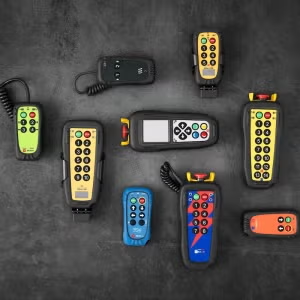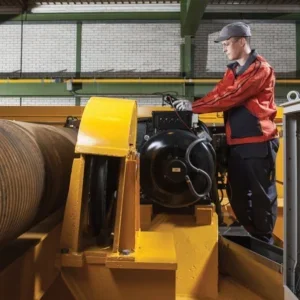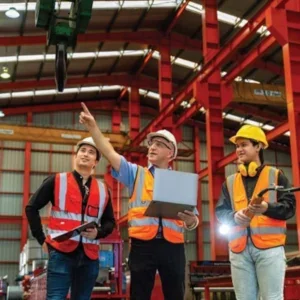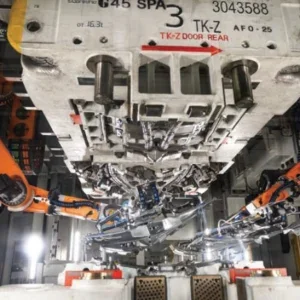Crane simulator systems allow operators and trainees to practise their skills in a safe, repeatable situation, whether to work on passing a test to achieve a level of certification, or just as a refresher course for an experienced operator who has been out of the game for a little while.
In the construction crane industry, it’s clear why simulators are valuable: as cranes in this sector, such as tower cranes and crawler cranes, are hired, the cost of giving an apprentice sufficient hours at the dashboard can be prohibitive. There are also the safety considerations of letting a novice operate such a large, and potentially unstable, piece of equipment.
Within the overhead lifting sector, one could imagine that there might be less call for simulators, as these cranes are permanently owned by users, thereby presenting more opportunity for use within training without the associated rental costs, and are ostensibly simpler pieces of equipment to operate.
In fact, the use of simulators is thriving and growing, as technology improves, prices fall, and the range of uses for simulators within overhead lifting broadens.
Firstly, there’s the question of when simulators are needed, and what they can be used for.
“Overhead cranes can be difficult to reserve for training as they’re usually in use,” says Drew Carruthers, director of training solutions at CM Labs, based in Montreal, Canada. “And while they may be technically less complex to manoeuvre than tower cranes, for example, they have the difficulty of being integrated into their surrounding environment. So they require awareness of what exists around the crane.”
That means that simulators are used for safety training, and not just for operators— anyone who might enter the factory floor can use a simulator to help understand the equipment, and the dangers and precautions required.
With regards to the environment around cranes, CM Labs offers a modelling service, through which a virtual recreation of a customer’s facility is produced, making training more focused and specialised. For smaller budgets, generic set-ups are available too, which still help to improve safety levels, says Carruthers.
Simulators are also used to help operators gain experience with new technologies, says Carruthers, for example the dual-hoist ship-to-shore crane simulator the company produced. That’s one of the systems that CM Labs has produced for dockside and port applications, which also include a simulation of an RTG 6+1 port crane.
Ultimately, a simulator increases the seat time of operators, says Carruthers, and CM Labs also helps its clients to adapt their training programmes to incorporate the simulator, to ensure that they are getting the most out of it: “For example, one customer had six simulators installed which were only being used during windy days, when the outdoor cranes could not be used for training; after working together on a training programme, combined seat time has doubled and the simulators are used more than the cranes.”
CM Labs has three main categories of customer for simulators: training schools; OEMs, who use simulators as marketing tools to present potential customers with a hands-on experience of a new crane or control system, and with many of whom CM Labs partners; and the industry itself, particularly as a relatively quick way of vetting applicants when hiring.
The company also works with the governing bodies that oversee certification, including recreations of their examination tests in the simulators to help trainees work through any pre-test nerves by running through the exams in advance.
There is also an opportunity for simulators to address the skills gap that has emerged in the lifting industry, notes David Clark, product marketing manager at CM Labs: “By bringing simulators into schools, the industry can not only introduce students to careers in lifting, but also demonstrate to parents that this presents a fairly straightforward path to a good income.”
Utah-based GlobalSim has seen its customer base expand since it launched virtual reality (VR) simulators for overhead lifting in 2016. “We’ve been in the crane simulator business for around 25 years,” says Brad Ball, vice president of sales at GlobalSim. “Our primary business is simulators for the US military and shipto- shore cranes. We have dozens of our simulators in operation around the world, and these systems tend to be large, and contained within a box with nine or ten LED screens.
“Part of the challenge for the overhead and construction crane industries was that customers didn’t have a need for such large simulators. In 2016, VR technology was sufficiently advanced, with enough processing power, for our engineers to use it to produce a hi-fi simulation system for overhead lifting.”
A key role of the latest-generation VR technology is removing ‘sim sickness’, an issue caused by a low frame rate, and subsequent lag between the wearer of the VR headset turning their head and their virtual surroundings moving. This can cause nausea and was prohibitive to VR headsets being more widely used for high-tech applications.
VR has proved a big selling point, says Ball, as it gives the trainee an unlimited field of view. “They’re immersed in quite a miraculous way,” says Ball. “All the physics are real.”
For customers who don’t have a need for a conventional, large simulator, the VR system offers a suitable solution, at a much lower cost, for overhead crane applications. GlobalSim is currently modifying the product further with a more basic, lowercost version due for launch next year.
This relatively new affordability of simulators is changing training in North America, says Ball.
“Big customers may have a lot of money, but their training departments are not always well-funded. When simulators became more affordable, a wider range of customers became interested. A year from now we’ll be in an even better situation as the new system will be for everyone, even, for example, high schools.
“One of our most popular products, which only costs a few thousand dollars, is a hand-eye-foot co-ordination device. This could be used for vetting applicants to an apprenticeship scheme, where there is no guarantee of existing skill level. Our customers say that they’d find out if an applicant wasn’t cut out for the role after about three weeks, but with this device, they find out straight away. We’re seeing this system used more and more.”
If the hand-eye-foot co-ordinator is a first stage in training crane operators, the next stage will be a simulator, where trainees can practise different scenarios and lessons, says Ball. On some of their more advanced systems, a scenario creator enables specific tasks and environments to be created.
Again, these scenarios can include the tests set by industry bodies, enabling operators to become familiar with examinations before taking them. “This is a huge advantage,” says Ball. “We had a software engineer who practised solely on the simulator, then took the test and passed.”
And for customers working with a higher budget, a facility can be recreated virtually and simulated—for example a steel mill, says Ball.
Scale and efficiency
“The overhead crane simulator is a great resource for any training programme with high capacity or large workforce training needs,” says Grant Winters, director of business development for VR at Washington-based Industrial Training International (ITI).
“We service customers that have anywhere from a few dozen overhead cranes on sites, all the way up to over 100. This is problematic as there are many people that work in those environments that are responsible for operating or supervising overhead crane lifting activities. Often there are 6–10 times more personnel on these sites that need overhead crane training than compared to smaller groups of skilled operators that run large mobile cranes or other specialized cranes like large crawlers or tower cranes.
“The issue becomes apparent when you are training many individuals quickly to prepare them to operate overhead cranes but because of production speed or line availability, they may only actually get 4–8 hours of hands-on training before they are expected to work with the equipment in a supervised or on-the-job training style role. We have seen this occur in our instructor led training as well when we go onsite for a one-day training programme and end up getting reduced time, or no time at all, on the cranes because of maintenance or production needs that don’t allow for access to the cranes needed. With the overhead crane simulator, we can give an operator quite a bit more immersive operation training in an on-demand as needed environment to help prepare them better and increase their speed to proficiency with the equipment.”
The results, says Winters, are increased efficiency and economics in crane training, particularly so with the latest simulator technologies: “Simulators continue to improve and are excellent supplements to any crane training programme. They help provide a safer training environment, more access to seat time training and different crane training scenarios, as well as time and equipment savings compared to 100% use of actual cranes and supervised training.
“Simulators in the past have been big, hardware intensive, capital expense items that have at times proven very cumbersome, hard to maintain, and short on life cycles due to changes in technology. With the rapid improvements in both hardware and software available in today’s market, we are beginning to see much more simulator demand for industrial training applications, especially in markets or with customers that would have never considered them before due to cost factors. ITI’s VR Simulation products offer a much different immersive experience than what screen-based simulation in the past has provided. The current and next generations of operators and industrial craft workers have also grown up with technology at their fingertips and are proving they can and will interact with it in both training and in the field more seamlessly.”
At CM Labs, the company has seen their simulators improve operator efficiency through practice, says Carruthers: “We’ve seen our port crane simulators, for STS and RTG cranes, help operators improve their skills to the point where they can move 27 containers an hour rather than 25 an hour. So the companies who purchase the simulators can get their investments back S GlobalSim’s bridge crane simulator very quickly.”
Portable, affordable training tools such as simulators also address the skills gap, adds Carruthers: “Previously, trainees would have to go to the crane to practice. Now, a simulator can come to you—and can be used in remote communities, for example at the location of a new mining development.
“They can also address the gender gap in the industry; female operators typically start at a higher level of competence as they are more cautious and respectful of the equipment. Simulators give them the opportunity to practice in a less intimidating atmosphere than a male-dominated environment.”
Increasingly suitable
As costs of simulators decrease and capabilities of the systems improve, more and more applications are becoming viable. The choice of VR or traditional simulators for specific types of crane is an interesting topic, as Brad Ball at GlobalSim explains:
“For some port crane simulators, for example very large ship-to-shore cranes, the operator is looking at something 100m away, and with a VR headset, the size of the screen and the resolution aren’t suitable. Also, with the position of the operator on an STS or RTG crane, they spend a lot of time looking straight down, and the headset can cause strain on their neck. Therefore, port training providers are more interested in our traditional simulators, which offer higherresolution displays.”
Indeed, GlobalSim provided the largest crane simulator in the world—an 11m-high system to a customer in Casablanca, Morocco—says Ball.
“Conversely, for overhead crane simulators, where there are no long distances to replicate, a VR headset is perfect,” he continues. “We manufacture all our hardware and software in-house, which is particularly good for us as it allows us to control and optimise product quality.”
ITI work with customers in a range of end-use sectors to develop simulators with the capabilities they require, says Winters: “ITI services many customers in large, high-speed manufacturing environments for rigging and overhead crane training. We knew there was a need for helping customers to improve their processes and overall training programmes and resources. We work with customers in steel production, aerospace, rail and barge manufacturing, auto manufacturers, nuclear power and power generation utilities, as well as the government. Many expressed interest in a product that helps them get additional training exposure to a piece of equipment that is difficult to schedule time on and would also help improve the speed to proficiency of their operators. We had several of these customers join our Overhead Crane Technical Advisory Group (TAG) to help us understand the needs and challenges faced that we could address with overhead crane simulation.
“The ITI VR Crane Simulator can function as an in-cab seated overhead crane control station, where the operator works in a cab environment—similar to a mobile crane—that is located up near the bridge of the equipment. This is common for many large capacity overhead cranes throughout several industries, but especially prevalent in heavy manufacturing and production mills for steel and metal alloys. We are also able to use it with a belly box remote control from ground level, which is becoming a much more common operation method for most industries. To be able to offer this orientation for training is a really big benefit in VR as it is difficult to do authentically with screens or other 2D displays.”
For CM Labs, creating an authentic experience on their simulators that feels as realistic as possible is key. “We produce smart training technology, using decades of research into getting the modelling as close as possible to reality,” says Carruthers. “We get operators in and ask them, does this feel real?
“We run 20,000 daily automated tests on computers as part of the process. We include details such as the hook block being simulated using 47 parts of line, rather than just one. On our ship-to-shore crane simulator, if the operator is picking a container from the last row, they’ll feel the boom flex—and it will flex more if the twist locks aren’t removed.
“We want the experience to be transferrable to real equipment. You can feel it in the seat of your pants; we can replicate vibrations, we have motion actuators, any distraction that an operator might encounter.
“We build everything in-house, and that allows us to develop products that we couldn’t with commercial software—we also develop simulation software for clients such as research labs and OEMs.”
Client feedback is crucial, adds Carruthers: “Our products often start as bespoke projects, which are then improved by market research and work with some customers, and turned into a product. When you’re blessed with people like our partners and the OEMs we work with who trust you, you hold onto them.”






